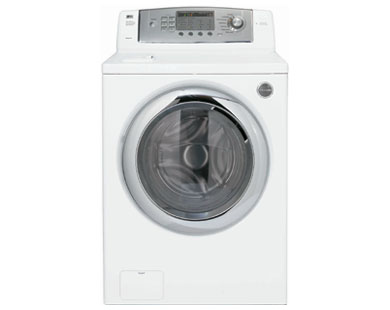|
Thread Number: 13180
Washer capacity question... |
[Down to Last] |

|
| Post# 228591 , Reply# 1 8/8/2007 at 11:20 (6,098 days old) by brasilianguy () | ||
|
Ah, i forget to ask too.... is the Cabrio washer the biggest domestic washer in the world?? if not, what is?? | ||
| Post# 228596 , Reply# 2 8/8/2007 at 11:46 (6,098 days old) by sudsman () | ||
|
in commerial machines (always front loaders) 6 lbs pre cubic foot is the avg. used for loading.. I dont really know about a top load machine however.. | ||
Post# 228602 , Reply# 3 8/8/2007 at 11:56 (6,098 days old) by logixx  (Germany) (Germany) |
||

According to the service manual the Cabrio (without agitator) can handle 18 lbs. or 8.16 Kg of laundry. What's interesting about the pretty much identical AquaSmart washer by Fisher & Paykel: "AquaSmart™ offers a generous 15.5 lb (7 kg) capacity." (New Zealand manual) "AQUASMART™ offers a generous 8 kg capacity." (USA/Canada manual) Maybe the American versions have different software to accommodate a bigger load. At least that's how they often do it in Europe: increase the wash time and call it "Extra Capacity"... Alex | ||
Post# 228743 , Reply# 6 8/8/2007 at 18:40 (6,098 days old) by brisnat81  (Brisbane Australia) (Brisbane Australia) |
||
|
The Aquasmart is Rated at 8kg in AU. From Memory, Miele suggest about 10L of volume for each kg of capacity, in a FL machine. The problem when applying this system to a toploader that you cant pack full, is that 8kg of lace would require a lot more volume than 8kg of denim. | ||
| Post# 228955 , Reply# 8 8/9/2007 at 09:37 (6,097 days old) by funguy10 () | ||
|
The Cabrio is the Whirlpool version of the Kenmore Oasis and the Oasis has 4.5 ft "Canyon Capacity". | ||
Post# 229122 , Reply# 9 8/9/2007 at 20:52 (6,097 days old) by toggleswitch  (New York City, NY) (New York City, NY) |
||
|
| ||
Post# 229123 , Reply# 10 8/9/2007 at 20:55 (6,097 days old) by toggleswitch  (New York City, NY) (New York City, NY) |
||
|
Most manufacturers now sell machines (in standard cabinet size) which take ............9kg (just shy of 20lbs!!) How did the capacity nearly doubel with the outer cabinet the same? Did the machines become deeper than 60cm deep x 60cm wide (24" x 24")? I believe this is how Miele achieved larger capactity, at firs.t | ||
| Post# 229228 , Reply# 12 8/10/2007 at 08:20 (6,097 days old) by brasilianguy () | ||
|
ok..... i'm gonna send the home page link.... so, there you click in "Productos" and them "Lavadoras Automaticas" CLICK HERE TO GO TO brasilianguy's LINK | ||
Post# 229657 , Reply# 14 8/11/2007 at 17:19 (6,095 days old) by brisnat81  (Brisbane Australia) (Brisbane Australia) |
||
|
What is the actual Drum Volume In the Hoover, what is the actual drum volume to attain 9kg? An 80-90L drum wouldnt leave much room in the cabinet for OOB situations. LG and Whirlpool are big on overhyping their drum capacities over here. Their 7 and 8kg models hold far less than my 5.5kg Miele does. | ||
Post# 230047 , Reply# 17 8/12/2007 at 21:51 (6,094 days old) by launderess  (Quiet Please, There´s a Lady on Stage) (Quiet Please, There´s a Lady on Stage) |
||
Speaking of Basket Size
It was posted over on THS, that the new uber Miele washing machines sold in the US, instruct users to only fill the drum three-quarters full. So even though these machines are supposed to hold more than say a standard Miele, that is not really so, since one cannot "pack the drum", the way one can with other Miele units. While such tricks would'nt surprise me with some other washer makers, am rather taken aback by Miele, since they have commercial units that hold massive amounts and can be filled tight. | ||
| Post# 230100 , Reply# 18 8/13/2007 at 03:53 (6,094 days old) by askomiele (Belgium Ghent) | ||
|
The general rule to fill a frontloader is to fill it loosly and not pack the load and just fill it untill you can put your fist between the clothes and the upperside of the drum. I never read the manual so closely I just hook up fill and let it wash... | ||
| Post# 230566 , Reply# 20 8/14/2007 at 21:44 (6,092 days old) by mielew4840 () | ||
|
largest capacity I always thought this LG Tromm is the biggest washer. 3.8 0cubic feet. I once saw it at the local shop. It holds about 10kg 
| ||
| Post# 230614 , Reply# 21 8/15/2007 at 02:31 (6,092 days old) by lederstiefel1 () | ||
|
mieleW4840 Here in Leverkusen-Opladen we have a laundrette where I sometimes bring some work-cloths to be washed for our company. The owner bought already two of these machines and is absolutely content with them! Ralf | ||

 Comes to the Rescue!
Comes to the Rescue!